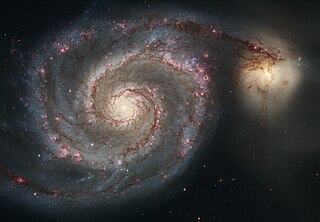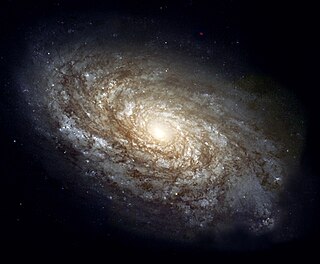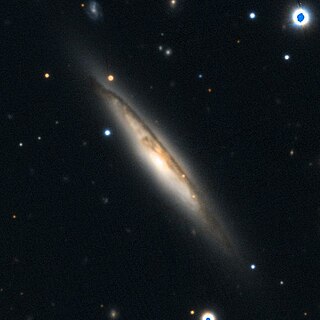Related Research Articles

NGC 4631 is a barred spiral galaxy in the constellation Canes Venatici. This galaxy's slightly distorted wedge shape gives it the appearance of a herring or a whale, hence its nickname. Because this nearby galaxy is seen edge-on from Earth, professional astronomers observe this galaxy to better understand the gas and stars located outside the plane of the galaxy.

The Leo Triplet is a small group of galaxies about 35 million light-years away in the constellation Leo. This galaxy group consists of the spiral galaxies M65, M66, and NGC 3628.

The M101 Group is a loose group of galaxies located in the constellation Ursa Major. The group is named after the brightest galaxy in the group, the Pinwheel Galaxy (M101). Most of the other members of the group are companions of the Pinwheel Galaxy. The group itself is one of many located within the Virgo Supercluster.

The NGC 4038 Group is a group of galaxies in the constellations Corvus and Crater. The group may contain between 13 and 27 galaxies. The group's best known galaxies are the Antennae Galaxies, a well-known interacting pair of galaxies.

NGC 4027 is a barred spiral galaxy approximately 83 million light-years away in the constellation Corvus. It is also a peculiar galaxy because one of its spiral arms goes out more than the other. This is probably due to a galactic collision in NGC 4027's past.
The M94 Group is a loose, extended group of galaxies located about 13 million light-years away in the constellations Canes Venatici and Coma Berenices. The group is one of many groups that lies within the Virgo Supercluster and one of the closest groups to the Local Group.
The M74 Group is a small group of galaxies in the constellation Pisces. The face-on spiral galaxy M74 is the brightest galaxy within the group. Other members include the peculiar spiral galaxy NGC 660 and several smaller irregular galaxies . The M74 Group is one of many galaxy groups that lie within the Virgo Supercluster.

The M109 Group is a group of galaxies about 55 million light-years away in the constellation Ursa Major. The group is named after the brightest galaxy within the group, the spiral galaxy M109.

NGC 3953 is a barred spiral galaxy located in the constellation Ursa Major. The galaxy is known to exhibit an inner ring structure that encircles the bar.

NGC 3384 is an elliptical galaxy in the constellation Leo. The galaxy was discovered by William Herschel in 1784 as part of the Herschel 400 Catalogue. The high age of the stars in the central region of NGC 3384 was confirmed after analysis of their color. More than 80% were found to be Population II stars which are over a billion years old. The supermassive black hole at the core has a mass of 1.6+0.1
−0.2×107 M☉.

The M51 Group is a group of galaxies located in Canes Venatici. The group is named after the brightest galaxy in the group, the Whirlpool Galaxy (M51A). Other notable members include the companion galaxy to the Whirlpool Galaxy (M51B) and the Sunflower Galaxy (M63).

The M96 Group is a group of galaxies in the constellation Leo. This group contains between 8 and 24 galaxies, including three Messier objects. It also contains the Leo Ring. The group is one of many groups that lies within the Virgo Supercluster.

The Coma I Group is a group of galaxies located about 14.5 Mpc (47.3 Mly) away in the constellation Coma Berenices. The brightest member of the group is NGC 4725. The Coma I Group is rich in spiral galaxies while containing few elliptical and lenticular galaxies. Coma I lies in the foreground of the more distant Coma and Leo clusters and is located within the Virgo Supercluster.

NGC 3981 is an unbarred spiral galaxy located 62 million light-years away in the constellation of Crater. It was discovered on February 7, 1785 by William Herschel.

NGC 668 is a spiral galaxy located 200 million light-years away in the constellation Andromeda. It was discovered by astronomer Édouard Stephan on December 4, 1880 and is a member of Abell 262.

NGC 669 is an edge-on spiral galaxy with an active galactic nucleus located 200 million light-years away in the constellation Triangulum. NGC 669 was discovered by astronomer Édouard Stephan on November 28, 1883 and is a member of Abell 262.

NGC 679 is an elliptical or a lenticular galaxy located 210 million light-years away in the constellation Andromeda. The galaxy was discovered by astronomer William Herschel on September 13, 1784 and is a member of Abell 262.

NGC 703 is a lenticular galaxy located 240 million light-years away in the constellation Andromeda. The galaxy was discovered by astronomer William Herschel on September 21, 1786 and is also a member of Abell 262.

NGC 753 is a spiral galaxy located 220 million light-years away in the constellation Andromeda. The galaxy was discovered by astronomer by Heinrich d'Arrest on September 16, 1865 and is a member of Abell 262.

NGC 759 is an elliptical galaxy located 230 million light-years away in the constellation Andromeda. NGC 759 was discovered by astronomer by Heinrich d'Arrest on September 17, 1865. It is a member of Abell 262.
References
- 1 2 3 4 5 A. M. Garcia (1993). "General study of group membership. II - Determination of nearby groups". Astronomy and Astrophysics Supplement . 100: 47–90. Bibcode:1993A&AS..100...47G.
- 1 2 3 4 5 6 7 8 G. Giuricin; C. Marinoni; L. Ceriani; A. Pisani (2000). "Nearby Optical Galaxies: Selection of the Sample and Identification of Groups". Astrophysical Journal . 543 (1): 178–194. arXiv: astro-ph/0001140 . Bibcode:2000ApJ...543..178G. doi:10.1086/317070. S2CID 9618325.
- 1 2 3 4 P. Fouque; E. Gourgoulhon; P. Chamaraux; G. Paturel (1992). "Groups of galaxies within 80 Mpc. II - The catalogue of groups and group members". Astronomy and Astrophysics Supplement. 93: 211–233. Bibcode:1992A&AS...93..211F.
- 1 2 R. B. Tully (1988). Nearby Galaxies Catalog. Cambridge: Cambridge University Press. ISBN 0-521-35299-1.
- ↑ H. Arp (1966). "Atlas of Peculiar Galaxies". Astrophysical Journal Supplement. 14: 1–20. Bibcode:1966ApJS...14....1A. doi:10.1086/190147.